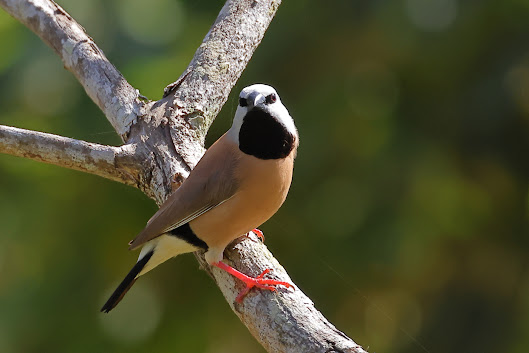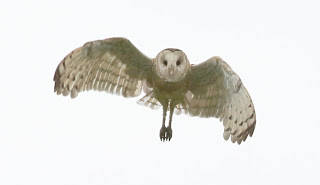Flying's not just about getting from there to here: Yellow-billed Spoonbill (Platalea flavipes) cruising in to a wetlands.
It can be aerial spotting for breakfast: Black-shouldered Kite (Elanus axillaris) hovers over pasture.
A means of collecting webbing for nest-building: Brown-backed Honeyeater (Ramsayornis modestus) engages in one-sided tug-o'-war.
Or just a way to find a place to be warm and look good: Blue-winged Kookaburra (Dacelo leachii).
Wish I could up and fly.
Wednesday, July 31, 2013
Sunday, July 28, 2013
Finches and Robin reward long standing
Stand around long enough and they will come . . . sometimes. Crimson Finch (Neochmia phaeton) selection from Mungalla . . .
. . . and Mangrove Robin (Peneonanthe pulverulenta) at end of Orient Station road.
(Some images duplicated in freeware tests)
Wednesday, July 24, 2013
Sacred Kingfisher happy little bugger
Sacred Kingfisher (Todiramphus sanctus) can be little buggers to sneak up on but this one at Mungalla Station yesterday was so enjoying sneaking up - and down - on many little bugs it ignored the Toyota Troopy following along the fenceline.
Sunday, July 21, 2013
Brown Songlark leads streaky run
What's brown and streaky and likes living among the grass and cattle? Take your pick, from Mungalla Station last three days: Most recent newcomer to total list of sightings since October, Brown Songlark (Cincloramphus cruralis). First I've found in the Ingham area. Seen Friday, no sign yesterday.
Quiet Stubble Quail (Coturnix pectoralis), one of three making quick little runs and flights yesterday. Last sighted late April, but almost certainly resident on the station.
Plenty of Golden-headed Cisticola (Cisticola exilis) amid the grass and hymenachne in yesterday's warm and still weather, after seeming absent during the previous week's drizzle and gusty grey days.
Keener on bare dirt than grass, Australian Pratincole (Stiltia isabella), one of 10-20 calling Mungalla home, with many more likely to turn up soon.
Thursday, July 18, 2013
Seeing and believing swallowed up
Bit of love and sharing between species? Nope, just an ambiguous picture. Sacred Kingfisher pounced on grasshopper and flew up to cottonwood branch. Rainbow Bee-eater turned casually to eye the newcomer. Grasshopper vanished down kingfisher gullet in a flash. Birds flew off a few seconds later.
Close by, my toothy mate at Mungalla Station begins a leisurely descent to the security of his or her waterhole: 3-3.5m of Saltwater Crocodile menace looks unthreatening. Another case of appearances being deceptive.
Another breezy day, another shot of male Leaden Flycatcher clinging to a fence. Missing pieces? Bits of steel cloned out. Another picture doing a bit of fibbing.
Close by, my toothy mate at Mungalla Station begins a leisurely descent to the security of his or her waterhole: 3-3.5m of Saltwater Crocodile menace looks unthreatening. Another case of appearances being deceptive.
Another breezy day, another shot of male Leaden Flycatcher clinging to a fence. Missing pieces? Bits of steel cloned out. Another picture doing a bit of fibbing.
Monday, July 15, 2013
Flycatchers Leaden and Restless stay low
Too windy for snatching insects high in trees at Mungalla Station today so male Leaden Flycatcher (Myiagra rubecula) stayed low and foraged among sicklepod and other weeds.
So too did much this Restless Flycatcher (Myiagra inquieta), much less common species in the Ingham area. About six years since my last local sighting.
So too did much this Restless Flycatcher (Myiagra inquieta), much less common species in the Ingham area. About six years since my last local sighting.
Friday, July 12, 2013
Tyto fire trails slashed lately as ground dries, giving some access to Eastern Grass-Owl (Tyto longimembris) habitat. Walk through scleria, hymenachne and matted grasses yesterday brought two owls from cover. Probably breeding pair now without the third seen with them before the Wet set in and closed the area in January. More, as they say, and better to come.
Tuesday, July 9, 2013
Chestnut-breasted beauties one and all
Sitting pretty, Chestnut-breasted Mannikin (Lonchura castaneothorax) at Mungalla Station pauses on hymenachne stem yesterday.
The bird wasn't flying solo: about half a flock of 500 or so fills the frame. Big flocks, sometimes of almost solely immature birds, relatively common at this time. (Hymenachne, a persistent and highly invasive weed, is loved by birds and enjoyed by cattle.)
The bird wasn't flying solo: about half a flock of 500 or so fills the frame. Big flocks, sometimes of almost solely immature birds, relatively common at this time. (Hymenachne, a persistent and highly invasive weed, is loved by birds and enjoyed by cattle.)
Sunday, July 7, 2013
Sneaky Salty stalks lucky ducky
Looking sharp on wee mud island in Mungalla Station lagoon yesterday, small Saltwater Crocodile yawns in the sun. Sneaky saurian eyed a snoozing Pink-eared Duck for long time. Slithered closer. Closer still. Eased into water. Duck peered about. Shifted from water's edge. Peered about. Shifted. Peered. Shifted. Shifted. Peered. Eased into water. Paddled slowly off. Missed eyes breaking surface two metres back. Paddled. Eyes follow. Paddled. Eyes closer. Paddled over shallower water. Eyes turn away. Anticlimax. But absorbing.
Long way off, the first migratory shore bird of the season sighted, male Pacific Golden Plover (Pluvialis fulva) still in full northern breeding plumage. Scores more will be on the way.
Long way off, the first migratory shore bird of the season sighted, male Pacific Golden Plover (Pluvialis fulva) still in full northern breeding plumage. Scores more will be on the way.
Friday, July 5, 2013
Big mornings with two Mr Bigs
Big morning near Wallaman Falls featured leisurely walk down the road with resident Mr Big, Southern Cassowary (Casuarius casuarius). Not much fallen tucker about the place so fruitful stops proved rare. Three birds seen together lately so breeding seems probable. Good news for the endangered species.
Another Mr Big, Australian Bustard (Ardeotis australis), the continent's heaviest flyer, pauses during a morning stroll at Mungalla Station, just east of Ingham. Four birds at present call the station's paddocks home.
Biggish bird feeding big appetite at Tyto Wetlands the other day, Pacific Heron (Ardea pacifica). Though striking mostly at prey in mud and shallow water, the bird didn't neglect its greens. Something for parents of fussy feeders to consider given talk of people going insectivorous?
Another Mr Big, Australian Bustard (Ardeotis australis), the continent's heaviest flyer, pauses during a morning stroll at Mungalla Station, just east of Ingham. Four birds at present call the station's paddocks home.
Biggish bird feeding big appetite at Tyto Wetlands the other day, Pacific Heron (Ardea pacifica). Though striking mostly at prey in mud and shallow water, the bird didn't neglect its greens. Something for parents of fussy feeders to consider given talk of people going insectivorous?
Monday, July 1, 2013
Getting on board without ducks
Great times lately at Mungalla Station near Ingham trying for pictures of seldom seen ducks. Without success. But there are always compensations, including close encounter with Australasian Grebe (Tachybaptus novaehollandiae).
And here's a Pallid Cuckoo (Cacomantis pallidus) paying one of its infrequent visits to the area.
Sometimes a passing Brolga (Grus rubicunda) gets close enough to fill the frame.
Not so often seen up this way, Australian Raven (Corvus coronoides). So-so image, but immature bird shows species' long throat hackles.
The ducks stay on the list.
And here's a Pallid Cuckoo (Cacomantis pallidus) paying one of its infrequent visits to the area.
Sometimes a passing Brolga (Grus rubicunda) gets close enough to fill the frame.
Not so often seen up this way, Australian Raven (Corvus coronoides). So-so image, but immature bird shows species' long throat hackles.
The ducks stay on the list.
Subscribe to:
Posts (Atom)
Lament for southern Black-throated Finches
Hollow logs for at risk birdies? Nature's nest boxes if you please Oh, such a clever wheeze So gather in twos and threes? Hundreds you w...

-
White-faced Heron stands up and begs picture be taken at Tyto. The birds can develop some trust in people, but I've never found any aro...
-
Munching on mantids, it's what Pacific Bazas do. Putting it another way, preying on Praying Mantises makes their mornings. Specially whe...
-
Who gives way on footbridge, Yellow-spotted Monitor or unspotted bird watcher? Naturally, dinkum locals have right-of-way. I step aside, Spo...












































